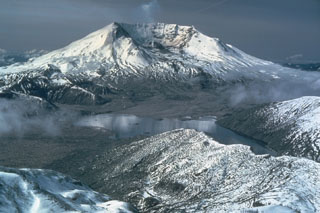Report on St. Helens (United States) — March 1983
Scientific Event Alert Network Bulletin, vol. 8, no. 3 (March 1983)
Managing Editor: Lindsay McClelland.
St. Helens (United States) SO2 emission, seismicity, and changes in morphology of new lobe may indicate continued endogenous growth
Please cite this report as:
Global Volcanism Program, 1983. Report on St. Helens (United States) (McClelland, L., ed.). Scientific Event Alert Network Bulletin, 8:3. Smithsonian Institution. https://doi.org/10.5479/si.GVP.SEAN198303-321050
St. Helens
United States
46.2°N, 122.18°W; summit elev. 2549 m
All times are local (unless otherwise noted)
CVO personnel report that frequent rockfalls from the toe of the February lobe and changes to its morphology, coupled with elevated SO2 emission and small seismic events, may reflect continuing endogenous dome growth. Poor weather limited visibility and restricted access to the crater through March and early April.
A new incandescent radial fissure was observed on the NE side of the February lobe during a night overflight 23 March and remained visible through the end of the month. ln the past, such fissures have typically formed during periods of rapid endogenous growth. By 31 March a mound of rubble estimated from brief aerial observations to be roughly 50-60 m in diameter and 20-30 m high had developed on the lobe, in the area where a spine had been extruded in late February. Frequent rockfalls from the E end of the lobe were continuing on 11 April, but conditions in the crater prevented geologists from mapping changes to the lobe front. Gas and ash explosions, some of moderate size, were observed or detected seismically roughly 1-2 times per day through early April. Most appeared to originate from fumaroles at the top of the dome. The main fumarole, a conical pit tens of meters in diameter at the surface and tens of meters deep, was located at the head of the E-flank notch that was the source of the February lobe.
Rates of SO2 emission remained elevated through early April, averaging 150 ± 95 t/d in March, only 20 t/d less than the February mean. Early April values ranged from 135 to 180 t/d. In contrast, rates in the months prior to January were only about 35 t/d. Deformation of the N and W sides of the dome continued but did not accelerate in March. Measurements of the deformation of the active E side of the dome have not been possible.
Extremely small events, felt by field crews in the crater but recorded only by a single seismometer 1 km N of the dome, continued through March. The number of larger earthquakes remained above background levels, averaging about half a dozen per day. This value oscillated considerably, without obvious trends or apparent correlations with variations in activity at the dome, but dropped substantially after the early March increase (SEAN 08:03). Seismic energy release exceeded previous post-extrusion periods. In the past, 90-95% of cumulative energy release had occurred during extrusion episodes, but this pattern changed in October 1982, and seismic energy equivalent to two typical extrusions has been released since then. However, seismic energy accompanying extrusion of the February lobe was unusually low, comparable to that associated with smaller extrusions such as in October 1981. Energy release in early April exceeded February rates.
Geological Summary. Prior to 1980, Mount St. Helens was a conical volcano sometimes known as the Fujisan of America. During the 1980 eruption the upper 400 m of the summit was removed by slope failure, leaving a 2 x 3.5 km breached crater now partially filled by a lava dome. There have been nine major eruptive periods beginning about 40-50,000 years ago, and it has been the most active volcano in the Cascade Range during the Holocene. Prior to 2,200 years ago, tephra, lava domes, and pyroclastic flows were erupted, forming the older edifice, but few lava flows extended beyond the base of the volcano. The modern edifice consists of basaltic as well as andesitic and dacitic products from summit and flank vents. Eruptions in the 19th century originated from the Goat Rocks area on the N flank, and were witnessed by early settlers.
Information Contacts: T. Casadevall, C. Newhall, USGS CVO, Vancouver, WA; S. Malone, University of Washington.

